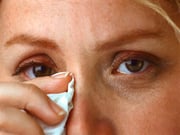
TUESDAY, March 16, 2021 (HealthDay News) -- Dutch scientists report they have grown miniature tear glands that actually cry.
They say these organoids -- tiny 3D-structures that mimic the function of actual human organs -- could lead to new treatments for dry eye disease and other tear gland disorders.
"And hopefully in the future, this type of organoids may even be transplantable to patients with non-functioning tear glands," said researcher Marie Bannier-Hélaouët, a doctoral student in biology and stem cell research at Hubrecht Institute in Utrecht, Netherlands.
Researchers said the organoids they created could be used to study how certain cells in the human tear gland produce tears or fail to do so. Eventually, it may even be possible to transplant such organoids into people whose tear glands don't work.
Located in the upper part of the eye socket, the tear gland secretes fluid that lubricates and nourishes the cornea. Tears also have antibacterial properties.
"Dysfunction of the tear gland, for example in Sjögren's syndrome, can have serious consequences including dryness of the eye or even ulceration of the cornea. This can, in severe cases, lead to blindness," said Dr. Rachel Kalmann, an ophthalmologist from UMC Utrecht Hospital who participated in the research.
But exactly how tear glands function was unknown and there was no reliable model to study them.
For this study, researchers used organoid technology to grow miniature versions of mouse and human tear glands in a dish, and then found a way to make them cry.
"Organoids are grown using a cocktail of growth-stimulating factors. We had to modify the usual cocktail to make the organoids capable of crying," Bannier-Hélaouët said in a Hubrecht Institute news release.
Researchers found that the right mixture of growth factors could induce the organoids to cry. Here's a video of the organoids doing just that in the lab:
"Further experiments revealed that different cells in the tear gland make different components of tears. And these cells respond differently to tear-inducing stimuli," said team member Yorick Post, who was at the Hubrecht Institute during this project.
Researchers said these organoids can be used to test new drugs for people who don't produce enough tears and to study how cancers of the tear gland form and may be treated.
The findings were published March 16 in the journal Cell Stem Cell.
More information
The U.S. National Eye Institute has more on dry eye.
SOURCE: Hubrecht Institute, news release, March 16, 2021
Back

The news stories provided in Health News and our Health-E News Newsletter are a service of the nationally syndicated HealthDay® news and information company. Stories refer to national trends and breaking health news, and are not necessarily indicative of or always supported by our facility and providers. This information is provided for informational and educational purposes only, and is not intended to be a substitute for medical advice, diagnosis, or treatment.






